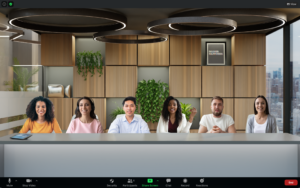Not surprisingly, one of the biggest anxieties – FEARS – for many faculty considering or implementing a HyFlex approach for the first time is learning how to do so, and to do so effectively the very first time. No one likes to feel like they aren’t equipped to do the work they are required (or challenged) to do; perhaps especially teachers who are normally in full control of their classrooms and the activities that take place in them. When you are planning to teach HyFlex, it may seem like you are planning for CHAOS, or at least planning to lose control over the class environment(s), the teaching process, and ultimately student learning. Let’s address those concerns one at a time, but briefly.
I had assumed that my experiences teaching in the classroom, online, and on Zoom would prepare me for this fall’s teaching situation. But HyFlex wasn’t just a combination of all of those methods (although it does borrow from all of them). HyFlex was a new teaching genre, and I needed to investigate this genre and address its limitations and possibilities.
Maria Bergstrom, Nov 25, 2020
https://www.facultyfocus.com/articles/online-education/teaching-hyflex-its-a-genre-problem/
Does teaching HyFlex mean that you give up control over the classroom environment(s)? No. Ultimately, the main aspect of teaching that you give up control over is deciding when students will participate in the classroom and when they will participate online when it comes to your traditional instructional practices. If you plan to teach in true HyFlex format, you will allow students the flexibility to decide which mode they’ll particpate in each time the class “meets.” Without flexibility, there is no HyFlex. But once students choose a mode, they are still required to participate in the learning experiences (accessing resources, completing activities, engaging in discussions, etc.) that you have prepared for them to do. Your goal is to help them achieve learning outcomes and objectives. And in your design process, you have drafted plans and resources for each mode so that you are reasonably sure that if they participate as you have asked them to in each mode, they should meet those outcomes. You don’t lose any control in any mode of HyFlex any more than you would in a single-mode class unless your design allows for that. (Sometimes you may want to give students more control over their specific activities in a mode, but that’s a topic for another post!)

Another aspect of fear when teaching HyFlex for the first time is associated with knowing how to do this well. Chapter 2.1 of the Hybrid-Flexible Course Design book explains a few foundational aspects of teaching in HyFlex, but it’s really just intended to get you started thinking about this. The assumption we usually operate with is that the faculty new to HyFlex have teaching expertise in one or more single-mode course formats, typically classroom instruction. Good assumption? Maybe – perhaps probably 🙂
If we assume you are an effective classroom teacher, then a common design path that I usually recommend is to start with your plans for an effective classroom experience and work to translate those to the other modes, accessing expert guidance as needed (such as, instructional designers, online course design books, your colleagues). What are the learning outcomes (or instructional objectives) for the classroom? How will those translate into the online mode(s) you are planning? What about the instructional content and associated activities for the classroom? How do those translate? What about plans for assessment? Start with what you know, and are confident with, and then layer in approaches for the other modes. You may need to learn a lot more about assessing in the online modes, and there are a lot of resources you can use to do so – but you have to take initiative to do so! It won’t happen without your effort and time. Along with outcomes, content and associated activities, and assessment, you should also plan out your engagement approach for each mode and across all modes. Engaged students start with an enthusiastically engaged teacher. If this isn’t you (yet), it needs to be! Chapter 1.4 of the Hybrid-Flexible Course Design book provides more guidance and tools to help with this design process.

One final element of HyFlex teaching fears for today: Will you lose control over student learning in a HyFlex course? This should be the most important anxiety one may bring to learning to teach HyFlex. Our instruction ought to be primarily about supporting student learning, and not about teacher control of detailed actions in class, perceptions of teacher perfection in conducting a class, or anything else. Do you believe students can effectively learn the course content and achieve the stated learning outcomes with your HyFlex course design? If not, you may have a serious problem. It could be that the HyFlex approach isn’t a good fit for your course (like for a complex lab class) or that your students don’t have adequate support for learning online (how can your institution provide this?), or maybe that your course design isn’t ready yet (keep working on it). If you do believe that students can effectively learn the course content and achieve the stated learning outcomes with the design you’ve created, then your fears may be primarily based on a lack of experience. How do you get that experience? “Just do it!” comes to mind. You have to teach HyFlex in order to learn how to teach HyFlex and to start defeating (or managing) the anxieties you may be facing.
(See the HyFlex Bibliography and Unit III Case Studies in the Hybrid-Flexible Course Design book for reports of student learning success in HyFlex courses.)

Courage is not the absence of fear. It is the willingness to act in the face of fear. Anxieties associated with teaching HyFlex may never fully go away (as they don’t for many of us in single-mode classes). If you want to better serve your students with more equitable access to high quality and flexible learning experiences, get help designing a robust HyFlex course, face the fear, be courageous, and get started! During our current crisis in education and in a post-pandemic world as well, we need more courageous teachers.
[…] Common Anxieties in Beginning HyFlex: Learning to Teach a HyFlex Class — from hyflexlearning.org by Brian Beatty […]
[…] Common Anxieties in Beginning HyFlex: Learning to Teach a HyFlex Class […]